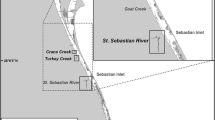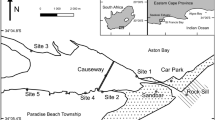Abstract
Samples of larval and juvenile fishes were collected at two depths weekly during spring and summer 1983 near the mouths of backwater areas in Pool 13 of the Upper Mississippi River. The study was conducted to determine the relative value of these habitats as nursery areas for fishes present and to note any interactions that might occur between the backwaters which are being rapidly lost to siltation, and the main channel. The larvae and juveniles collected represented 13 families divided into 27 lower taxa. Cyprinidae, Clupeidae, and Sciaenidae made up 90% of the total catch. Both larvae and juveniles were more abundant near the surface than near the bottom. Densities differed greatly among the three backwater areas studied. Larval fishes were grouped on the basis of their relative abundance in the backwaters or main channel. Overall, more larvae were captured in the backwaters than in main-channel habitats, indicating that backwaters were more productive. In the main channel, densities were greater downstream from the mouths of the backwaters than upstream-possibly indicating that (1) larval fish drifted out of the backwater areas, (2) water rich in nutrients or zooplankton that flowed into the main channel created productive downstream sites that were used as nursery areas, or (3) adult fishes selected downstream sites as spawning areas. Juvenile forms were more abundant in the backwater areas then in the main-channel habitats, some bottom-dwelling fishes excepted. The backwater areas were judged to be important nursery areas for larval and juvenile fishes, and seemed to benefit downstream main-channel sites. Any loss of these habitats would be detrimental to the Mississippi River as a whole.
Similar content being viewed by others
References
Bade, G., 1980. Side Channel Work Group appendix. Great River Environmental Action Team II, Upper Mississippi River (Guttenberg, Iowa to Saverton, Missouri): 194 pp.
Christenson, L. M. & L. L. Smith, 1965. Characteristics of fish populations in Upper Mississippi River backwater areas. U.S. Fish Wildl. Serv., Circ. 212: 53 pp.
Conner, J. V., C. H. Pennington & T. R. Bosley, 1983. Larval fish of selected aquatic habitats on the lower Mississippi River. U.S. Army Eng. Waterway Exp. Sta., Vicksburg, Miss. Technical Report E-83-4: 45 pp.
Eckblad, J. W., C. S. Volden & L. S. Weilgart, 1984. Allochtonous drift from backwaters to the main channel of the Mississippi River. Am. Midl. Nat. 111: 16–22.
Fuiman, L. A., J. V. Conner, B. F. Lathrop, G. L. Buynak, D. E. Snyder & J. J. Loos, 1983. State of the art of identification for cyprinid fish larvae from eastern North America. Trans. am. Fish. Soc. 112: 319–332.
Gale, W. F. & H. W. Mohr, Jr., 1978. Larval fish drift in a large river with a comparison of sampling methods. Trans. am. Fish. Soc. 107: 46–55.
Graser, L. F., 1978. Flow-through collection bucket for larval fish. Prog. Fish-Cult. 40: 78–79.
Harrow, L. G. & A. B. Schlesinger, 1980. The larval fish recruitment study. Omaha Public Power Dist., Omaha, Neb. Environmental Series Bull. 5: 92 pp.
Hergenrader, G. L., L. G. Harrow, R. G. , R. F. Cada & A. B. Schlesinger, 1982. Larval fishes in the Missouri River and the effects of entrainment. In L. W. Hesse, H. W. Lewis, S. D. Reetz, & A. B. Schlesinger (eds.), The Middle Missouri River. The Missouri River Study Group, Norfolk, Neb.: 185–224.
Holland, L. E. & J. R. Sylvester, 1983. Distribution of larval fishes related to potential navigation impacts on the Upper Mississippi River, Pool 7. Trans. am. Fish. Soc. 112: 293–301.
LePage, G. S., C. A. Weldon & H. H. Calhoun, 1979. Sediment and Erosion Work Group appendix to the Environmental Action Team I final report. Great River Environmental Action Team I, GREAT I study of the Upper Mississippi River, Technical Appendixes, Volume 4: F. Water Quality & G. Sediment and Erosion: 125 pp.
Mancini, E. R., M. Busdosh & B. D. Steele, 1979. Utilization of autochtonous macroinvertebrate drift by a pool fish community in a woodland stream. Hydrobiologia 62: 249–256.
Mason, J. C. & D. W. Chapman, 1965. Significance of early emergence, environmental rearing capacity, and behavioral ecology of juvenile coho salmon in stream channels. J. Fish Res. Bd Can. 22: 173–190.
Rasmussen, J. L., 1979. A compendium of fishery information on the Upper Mississippi River. Upper Miss. River Cons Comm., Rock Island, Ill.: 259 pp.
Robins, C. R., 1980. A list of common and scientific names of fishes from the Unites States and Canada. 4th ed. Am. Fish. Soc., Spec. Pub. 12: 174 pp.
Snyder, D. E., 1976. Terminologies for intervals of larval fish development. In: J. Boreman, (ed.), Great Lakes fish egg and larvae identification: proceedings of a workshop. U.S. Fish Wildl. Serv., Office Biol. Serv., FWS/OBS 76/23: 41–60.
Tarplee, W. H., W. T. Bryson, & R. G. Sherfinski, 1979. Portable push-net apparatus for sampling ichthyoplankton. Prog. Fish-Cult. 41: 213–215.
Tuberville, J. D., 1979. Vertical distribution of ichthyoplankton in upper Nickajack Reservoir, Tennessee, with comparison of three sampling methodologies. In: R. Hoyt (ed.), Proceedings of the third symposium on larval fish. Western Kentucky Univ., Bowling Green: 185–203.
Van Vooren, A., 1981. Relative utilization of Mississippi River habitats as nursery areas. Iowa Cons. Comm., Proj. 81-III-C-11: 103–122.
Yocum, W. L., & F. J. Tesar, 1980. Sled for sampling benthic fish larvae. Prog. Fish-Cult. 2: 118–119.
Author information
Authors and Affiliations
Rights and permissions
About this article
Cite this article
Sheaffer, W.A., Nickum, J.G. Backwater areas as nursery habitats for fishes in pool 13 of the Upper Mississippi River. Hydrobiologia 136, 131–139 (1986). https://doi.org/10.1007/BF00051510
Issue Date:
DOI: https://doi.org/10.1007/BF00051510




